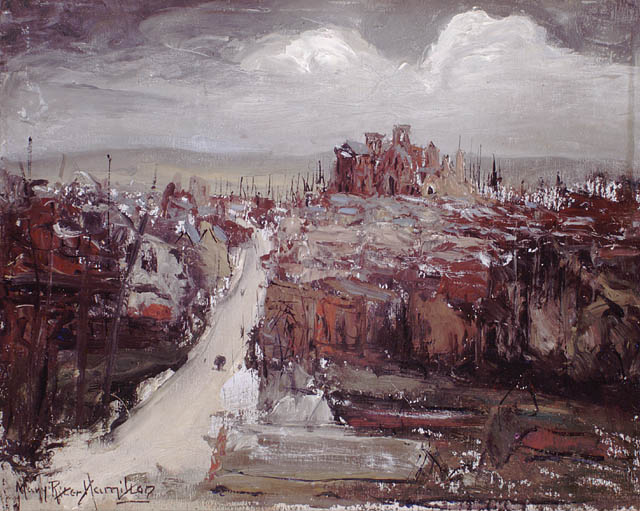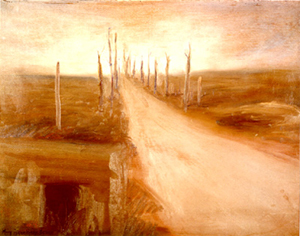|
|
|
|
MARY RITER HAMILTON:
Text: Manon Fontaine, Montreal
|
1918. Despite Armistice Day and the return of soldiers to Canada, a woman, Mary Riter Hamilton, got ready for the combat of her life, armed with canvases and brushes. This painter, a mature woman of 45, made it her mission to pay tribute to Canadian heroes, and she set off, by herself, for post-war Europe, wanting to immortalize its devastated lands. |
|
Commissioned by British Columbia’s Amputees Club to create paintings to illustrate their magazine, Gold Stripe, she crossed the Atlantic and discovered the shattered France of 1919. She faced very difficult living conditions—contaminated water, swarming vermin—and she had to take shelter in abandoned buildings, counting for her subsistence on the generosity of the few farmers who returned to the region. Every step she took marked her courage, since the fields riddled with unexploded shells, bombs and landmines, put her life in peril at all times.
From living so, Mary Riter Hamilton left behind the traditional academic style she had acquired in German and French studios and academies, and began to paint from emotions and feelings inspired by the landscapes she discovered. More than 350 paintings were born from her artistic way of the cross, each bearing witness to terrible, beautiful scenes. |
 Albert (Somme), route d'Amiens |
|
Trenches, villages in ruins and crosses
on tombs all served to immortalize the horror before which
humanity cannot erase all traces of this horrible war.
In 1923, having accepted to show some of her works at Paris’ Opéra and at London’s Surrey, she became immensely successful and reached the peak of her career. Moreover, in recognition of her exceptional contribution, the French government decorated her.
Despite such renown, it was a broken woman who returned to Canada after more than three years of being away. The constant stress, poor nutrition and overwork all played a part in ruining Mary’s health. She later returned to France a few times and soon experienced serious financial difficulties since she refused to sell any of the 350 canvases from her collection of paintings depicting deserted battle fields. In fact, her dearest wish, she said, was to donate the paintings to the National Archives of Canada in Ottawa so that they may benefit veterans, their families and the people taking care of them. |
 La mélancolie de la Somme |
Without a dime to her name and ill, Mary Riter Hamilton was hospitalized in Paris and lost sight in one eye. She gave up painting. To make enough money to return to Canada, she took to decorating fabric and won a medal of gold that attests to the quality of her creations. Having returned to Canada, she worked in a studio in Winnipeg then Victoria. Her integration into a society moving towards modernity became ever more difficult and she withdrew from public life. At the age of 80, she faded into oblivion.
1988. Dr. Angela Davis, associate professor at University of Manitoba’s St-John’s College, contacted the War Amputees and took on the task of restoring Mary Riter Hamilton’s painting, which had long been forgotten in the National Archives of Canada. Thus, 70 years after the end of the WW I, the collection was put up for public view through a video documentary entitled Traces of War, produced by the War Amputees. |
| Following its showing, various museums showed the No Man’s Land collection consisting of some 40 of Mary’s paintings. In addition to the unveiling of such high-quality works, these exhibitions contributed to the resurrection of a brave woman who risked her life and risked it all to pay tribute to Canadian soldiers who fought in the WW I. |